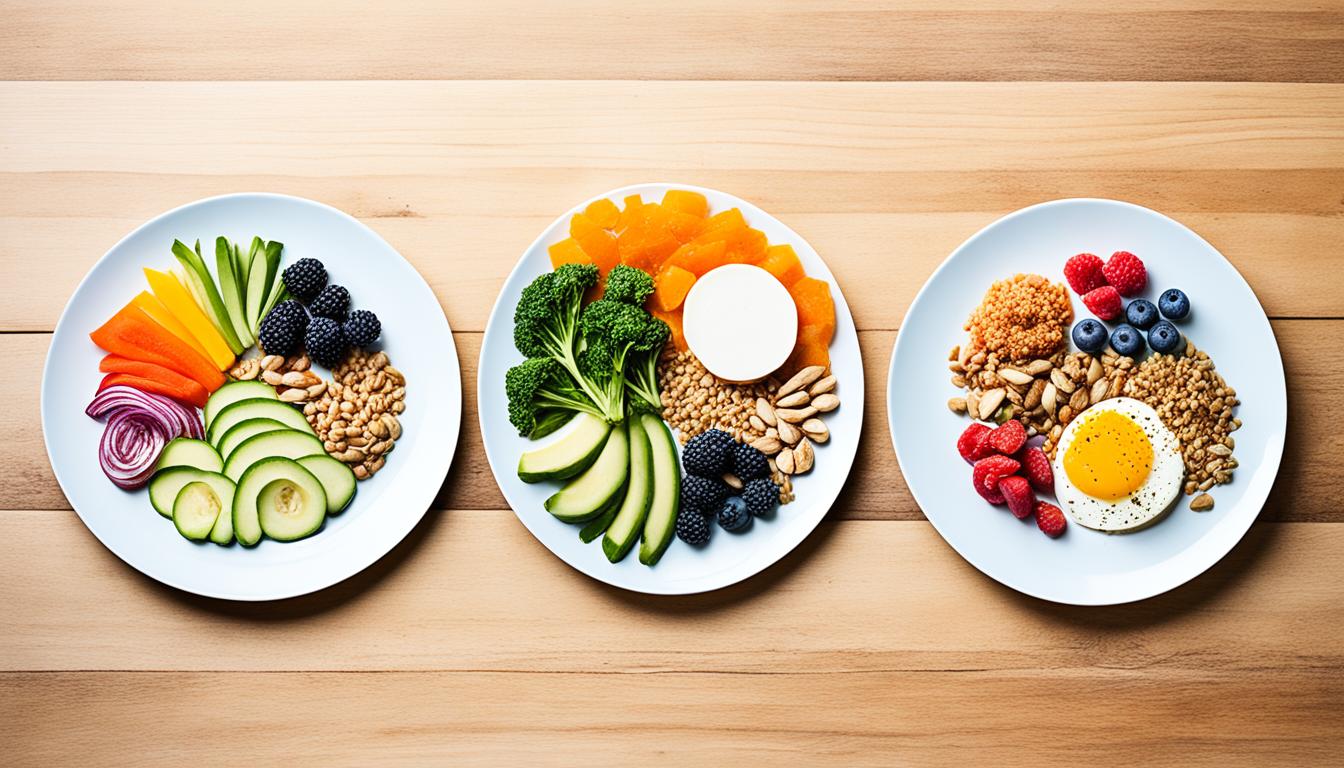In the world of healthy eating, two approaches stand out: mindful eating and intuitive eating. Wondering which one fits your life best? Let’s dive into the differences between these two eating styles.
Key Takeaways
- Understand the core principles of mindful and intuitive eating approaches.
- Discover the origins and benefits of adopting an intuitive eating lifestyle.
- Learn practical mindful eating techniques to incorporate into your daily routine.
- Explore the similarities and differences between mindful and intuitive eating.
- Uncover strategies to overcome challenges in embracing an intuitive eating mindset.
Introduction: Exploring Mindful and Intuitive Eating Approaches
Two approaches have become popular for a healthy food relationship: mindful eating and intuitive eating. They both focus on being more aware and in control of how we eat. They help change our eating habits in different ways.
What is Mindful Eating?
Mindful eating means eating with full attention. It’s about eating slowly, enjoying each bite, and listening to your body. This way, you make better food choices and enjoy eating more.
What is Intuitive Eating?
Intuitive eating is about listening to your body’s hunger and fullness signals. It’s not about following strict rules. It helps you build a good relationship with food and your body.
| Mindful Eating | Intuitive Eating |
|---|---|
| Emphasizes being present and aware during the eating experience | Focuses on honoring internal hunger and fullness cues |
| Cultivates a conscious and intentional relationship with food | Rejects external rules or restrictions in favor of internal guidance |
| Promotes savoring and appreciating each bite | Encourages a more positive, sustainable relationship with food |
Looking into mindful eating and intuitive eating can show you their benefits. This helps you build a healthy and rewarding relationship with food.
The Origins and Principles of Intuitive Eating
Intuitive eating was first introduced by Evelyn Tribole and Elyse Resch in 1995. They wrote a book that changed how we think about food and our bodies. This approach helps you build a healthy relationship with food and your body.
The 10 Principles of Intuitive Eating
The main ideas of intuitive eating are based on 10 key principles. These principles help you listen to your body’s hunger and fullness signals. They also help you stop following strict diets and improve how you see your body.
- Reject the Diet Mentality: Break free from the cycle of strict diets. Choose a health-focused approach instead.
- Honor Your Hunger: Listen to your body’s hunger signals to keep your energy up.
- Make Peace with Food: Allow yourself to enjoy all foods without guilt or shame.
- Challenge the Food Police: Stop judging your food choices. Be kind to yourself.
- Respect Your Fullness: Pay attention to when you’re full and stop eating then.
- Discover the Satisfaction Factor: Enjoy the taste and pleasure of your food to build a better relationship with eating.
- Honor Your Feelings Without Using Food: Find other ways to deal with your emotions instead of eating.
- Respect Your Body: Love and accept your body for what it can do and how it looks.
- Exercise—Feel the Difference: Do physical activities you like. Focus on how they make you feel, not just weight loss.
- Honor Your Health: Choose a flexible, mindful way of eating that focuses on your overall health, not strict rules.
By following these intuitive eating principles, you can improve your relationship with food and your body. This leads to better health and a more enjoyable eating experience.
Mindful Eating Practices and Techniques
Embracing Mindful Eating changes how you see food and eating. It makes you focus on the moment, listen to your body, and enjoy each bite. By using Mindful Eating Practices, you can eat better and feel better too.
One important thing to do is to slow down and really notice your food. Look at how it looks, smell it, feel its texture, and taste it. This way, you’ll feel closer to your food and more satisfied.
- Pause before eating to take a few deep breaths and mentally prepare for your meal.
- Eat slowly, putting your utensil down between bites, and avoid distractions like phones or screens.
- Tune into your body’s hunger and fullness cues, stopping when you feel satisfied rather than overly full.
- Engage your senses by noticing the colors, shapes, and textures of your food.
Another great way to practice Mindful Eating is with mindfulness exercises. Try a “raisin meditation” by looking closely at a raisin. Notice its look, feel, and taste. This helps you stay in the moment and enjoy eating more.
By using these Mindful Eating Practices, you’ll feel more thankful and happy with your meals. Eating with awareness can make your relationship with food healthier and more rewarding.
Benefits of Adopting an Intuitive Eating Approach
Embracing an intuitive eating lifestyle brings many physical and mental benefits. It helps you listen to your body’s hunger and fullness signals. This approach lets you move away from diet culture’s limits, changing how you see food and your health.
Positive Body Image and Self-Esteem
Intuitive eating promotes self-acceptance and body positivity. It encourages you to accept your body’s unique shape and size. This leads to better self-esteem and a more positive body image. This positive change affects many areas of your life.
Lower Rates of Disordered Eating
By saying no to diet mentality and listening to your body, you avoid unhealthy eating psychology behaviors. These include restriction, binge eating, or purging. Intuitive eating is linked to fewer cases of disordered eating. It helps you have a healthier relationship with food.
Higher General Well-Being
The benefits of intuitive eating go beyond food and body image. It can make you feel better overall. When you honor your hunger and respect your fullness, you enjoy eating more. This can lead to less stress, a better mood, and more life satisfaction.
| Benefit | Description |
|---|---|
| Positive Body Image and Self-Esteem | Intuitive eating encourages self-acceptance and a more positive perception of one’s physical appearance, leading to improved self-worth. |
| Lower Rates of Disordered Eating | Adopting an intuitive eating approach reduces the likelihood of engaging in unhealthy eating behaviors such as restriction, binge eating, and purging. |
| Higher General Well-Being | Intuitive eating can contribute to reduced stress, improved mood, and a greater sense of overall life satisfaction. |
“Intuitive eating has allowed me to find a peaceful and joyful relationship with food, freeing me from the constant battle of dieting and body image issues.”
Mindful Eating vs Intuitive Eating
Both mindful eating and intuitive eating help you build a healthy relationship with food. They share some similarities but also have key differences. It’s important to understand these differences.
Mindful Eating is about being fully present when you eat. It means enjoying the taste, smell, and feel of your food. You also pay attention to when you’re hungry or full. This helps you appreciate the food you eat more.
Intuitive Eating is about listening to your body’s needs. It says no to strict diet rules. Instead, you choose food based on what makes you happy.
| Mindful Eating | Intuitive Eating |
|---|---|
| Focuses on the present-moment experience of eating | Focuses on honoring internal hunger and fullness signals |
| Encourages awareness of senses (sight, smell, taste, texture) | Rejects diet mentality and external food rules |
| Promotes a deeper appreciation for the nourishment | Empowers you to make food choices that feel satisfying |
Both mindful eating and intuitive eating can better your relationship with food and boost your health. Knowing what each offers can help you pick the best approach for you.
Overcoming Challenges in Intuitive Eating
Switching to intuitive eating can be tough, especially if you’ve dieted a lot before. But, with the right mindset and strategies, you can beat these challenges. You can start to have a healthier, more balanced way of eating.
Rejecting Diet Mentality
One big challenge is letting go of the diet mentality. Years of dieting make it hard to trust your body’s hunger and fullness signals. To get past this, challenge negative thoughts about food and your body. Focus on listening to your body’s needs instead of strict rules.
Coping with Emotions Without Food
Many people eat to cope with stress, anxiety, or boredom. When you start intuitive eating, you might feel these emotions more strongly. It’s important to find other ways to deal with them, like mindfulness, journaling, or talking to friends and family.
Remember, changing to intuitive eating is a journey. Be patient and kind to yourself as you go. With time and effort, you can build a positive, empowered relationship with food and your body.

“The path to intuitive eating is not always linear, but with the right mindset and support, you can overcome the obstacles and thrive.”
Mindful Eating Strategies for Daily Life
In today’s fast-paced world, it’s easy to eat without thinking. By adding mindful eating practices to your day, you can enjoy your food more and have a better relationship with eating.
Eating with Awareness
Start by eating with full attention. Take a few deep breaths before eating to focus on the moment. Notice the smells, tastes, and textures of your food as you eat. This helps you feel satisfied and eat less.
Honoring Hunger and Fullness Cues
Learn to listen to your body’s hunger and fullness signals. Ask yourself, “Am I really hungry?” before eating. Stop eating when you’re full, not just because you’re done with your plate. This way, you eat just what you need and avoid overeating.
Using these mindful eating strategies can change how you see food and your body. It’s a journey, so be patient and kind to yourself as you find what works for you.
Discover how one woman foundsuccess with the Custom Keto Diet Plan, leading to significant weight loss and improved health without any required exercise
“The one lesson I’ve learned is that quiet time with my family – no phones, no distractions – is important. It’s not only important to my family, but important for my mental health.” – Michelle Obama
Raising Intuitive Eaters: Tips for Parents
As parents, you have a big role in how your kids see food. Teaching them about intuitive eating can help them have a good relationship with food. Here are some tips to help your kids eat healthily:
- Forfeiting Control: Don’t control what your child eats too much. Let them decide when they’re hungry or full.
- Creating a Pleasant Mealtime Environment: Make meals calm and free from distractions. This helps your child pay attention to their body’s signals.
- Enforcing Boundaries: Have regular meal and snack times. But let your child decide how much to eat from what you offer.
More tips for intuitive eaters include:
- Offering Foods Your Child Enjoys: Give your child a mix of foods they like to make eating positive.
- Modeling Intuitive Eating Behaviors: Show how you eat mindfully, like stopping when you’re full and enjoying your food’s taste.
- Being Open-Minded About Food Preferences: Don’t use food as a reward or punishment. Accept your child’s unique food choices.
Creating a supportive environment for healthy eating habits is crucial. It helps your kids become intuitive eaters. By using these tips, you can help your children have a good relationship with food for life.

“The way we feed our children can have a profound impact on their relationship with food for the rest of their lives.”
Incorporating Both Mindful and Intuitive Eating Practices
Mindful eating and intuitive eating can work well together. They help you take care of your body and mind. By mixing them, you can make a plan that suits you best.
Mindful eating means eating with full attention. You notice the taste, feel, and look of your food. Intuitive eating is about listening to your body’s hunger and fullness signals. Together, they help you understand your body’s needs and enjoy eating more.
Here are some ways to use both mindful and intuitive eating in your life:
- Slow down and savor each bite during meals, taking the time to truly experience the flavors and sensations.
- Check in with your body’s hunger and fullness signals throughout the day, and make adjustments to your eating accordingly.
- Experiment with different foods and preparation methods, exploring new flavors and textures that nourish both your palate and your body.
- Engage all your senses during mealtimes, taking in the sights, smells, and sounds of your food.
- Cultivate a non-judgmental, compassionate attitude towards your eating habits, focusing on progress rather than perfection.
By mixing mindful and intuitive eating, you can make a plan that’s good for you. It should support your health and happiness. Remember, what’s important is finding what’s best for you.
“The ultimate goal of both mindful and intuitive eating is to develop a positive, nurturing relationship with food and your body.”
| Mindful Eating | Intuitive Eating |
|---|---|
| Focuses on being present during the act of eating | Emphasizes honoring your body’s natural hunger and fullness cues |
| Pays close attention to flavors, textures, and sensations | Rejects the diet mentality and promotes a positive relationship with food |
| Cultivates a non-judgmental, compassionate attitude towards eating | Encourages exploring a variety of foods and preparation methods |
Conclusion
As we wrap up our look at Mindful Eating and Intuitive Eating, we see there’s no single best way to eat healthily. The debate between these two isn’t about picking a winner. It’s about finding what works for you.
We’ve looked into the roots, rules, and perks of Mindful Eating and Intuitive Eating. We’ve talked about the hard parts of breaking free from diet trends and handling emotions without eating. And we’ve shared tips on making these ways part of your everyday life, like eating with care or listening to your body’s hunger signals.
The main thing is to be open-minded and ready to try new things. By mixing Mindful Eating and Intuitive Eating ideas, you can build a strong, lasting bond with food. This bond feeds your body and lifts your spirit. Remember, your path to healthy eating habits is unique, and you get to decide how to move forward.






